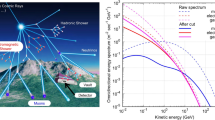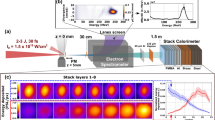Abstract
THE absorption curve for cosmic radiation in lead for small thicknesses of absorber (0–30 cm.) has been measured by many observers. The general shape of the curve is not in doubt, but several observers have obtained differences in detail. Clay1 and co-workers, using ionization chambers, have obtained three maxima at 1.5, 17 and 25 cm. These maxima disappeared when a Geiger–Müller telescope was employed and the absorber was placed within the telescope. With the absorber above the telescope, two rather extended maxima appeared at about 15 and 30 cm. Clay associates these with maxima observed in the absorption curve for showers. George and Appapillai2 have used a counter telescope with the absorber placed within it, and find a plateau region at about 10–17 cm., but no maxima. More recently, Fenyves and Haiman3 have obtained pronounced maxima in the absorption curve at 17 and 25 cm. They used counter telescopes and determined two consecutive points simultaneously. (The position of the absorber is not mentioned.) George, Jánossy and McCaig4 report that the second maximum in the shower curve is instrumental and not real, unless it be very small.
This is a preview of subscription content, access via your institution
Access options
Subscribe to this journal
Receive 51 print issues and online access
$199.00 per year
only $3.90 per issue
Buy this article
- Purchase on Springer Link
- Instant access to full article PDF
Prices may be subject to local taxes which are calculated during checkout
Similar content being viewed by others
References
Clay, J., Venema, A., and Jonker, K. H. J., Physica, 7, No. 8 (1940).
George, E. P., and Appapillai, V., Nature, 155, 726 (1945).
Fenyves, E., and Haiman, O., Nature, 165, 244 (1950).
George, E. P., Jánossy, L., and McCaig, M., Proc. Roy. Soc., A, 180, 219 (1942).
Author information
Authors and Affiliations
Rights and permissions
About this article
Cite this article
HEYLAND, G., DUNCANSON, W. Absorption of Cosmic Rays in Lead. Nature 167, 895–896 (1951). https://doi.org/10.1038/167895a0
Issue Date:
DOI: https://doi.org/10.1038/167895a0
This article is cited by
-
Sunti delle comunicazioni presentate al XXXVIII Congresso della Società
Il Nuovo Cimento (1953)
-
Anomalies of the absorption curve of cosmic radiation in lead
Il Nuovo Cimento (1952)
Comments
By submitting a comment you agree to abide by our Terms and Community Guidelines. If you find something abusive or that does not comply with our terms or guidelines please flag it as inappropriate.



